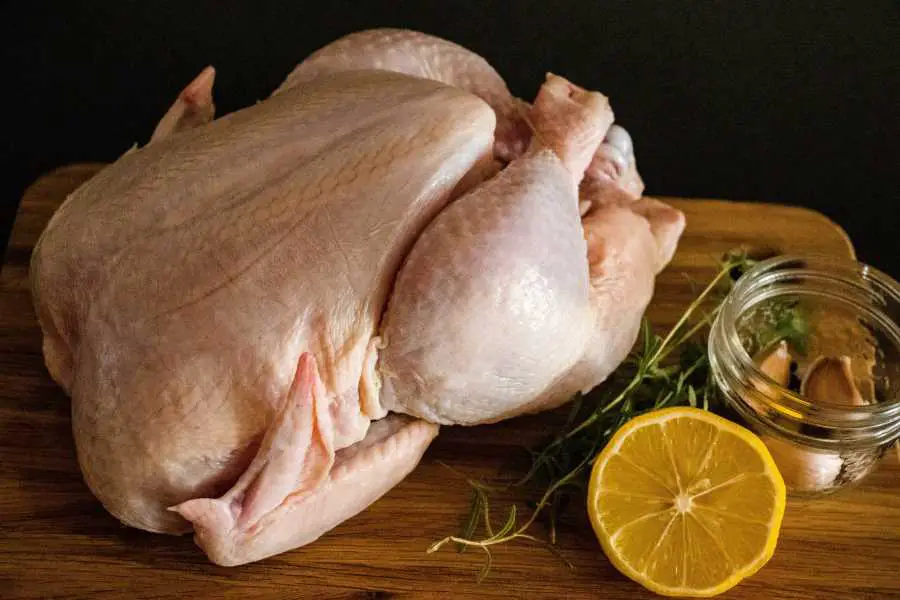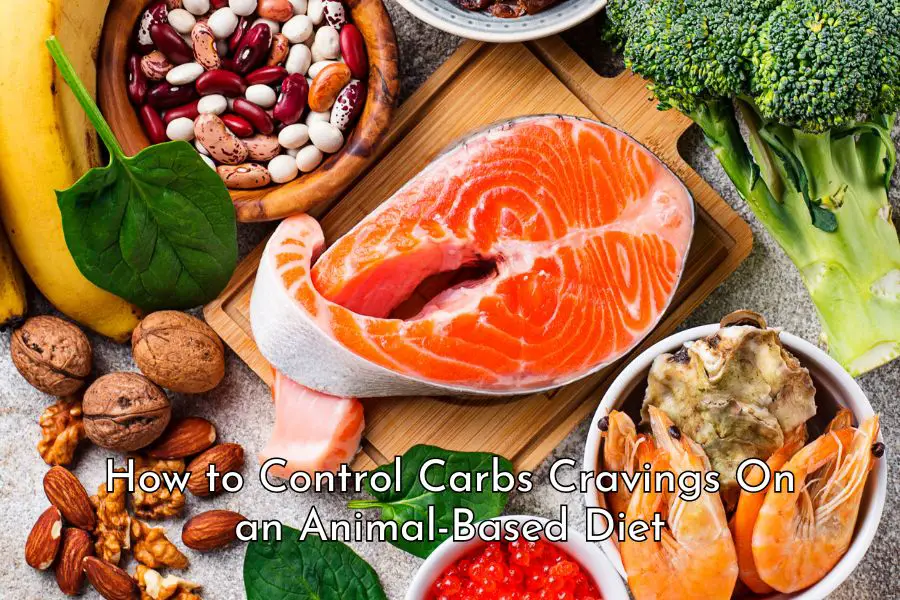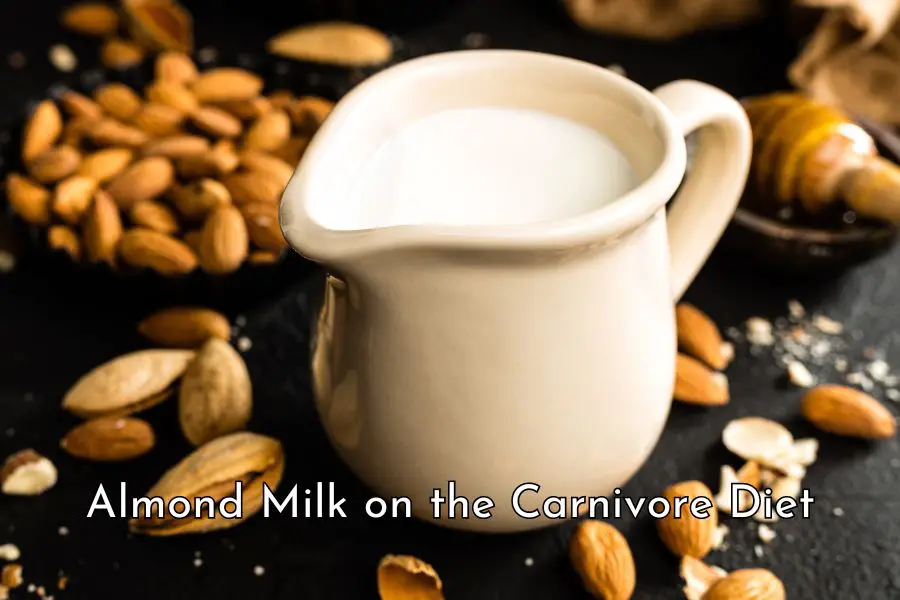Meat, fat, and organs from ruminants like cows, sheep, and goats are generally considered the best food to eat on the carnivore diet because they are generally better raised and have a better nutritional profile.
But what about chicken? Is it okay to eat chicken on the carnivore diet?
Chickens are incredibly nutrient dense and it is perfectly fine to eat as much chicken as you like on the carnivore diet if you have access to genuine pasture-raised chicken meat.
However, if you can only get conventionally-raised chicken, it is best to avoid it altogether or eat it very sparingly because they are poorly raised, fed a species-inappropriate diet, and have an inferior nutritional profile compared to ruminants.
This would be the case for the vast majority of consumers because most of the chicken available on the market today comes from intensive farming operations.
Until chicken farming standards improve substantially, make ruminant meat, fat and organs the centre of your carnivore diet.
Table of Contents
- Nutritional Profile of Chicken
- Difference Between Pasture-Raised Chicken and Conventionally-Raised Chicken
- Why It’s Okay to Eat Pasture-Raised Chicken on the Carnivore Diet
- Why You Should Avoid Conventionally-Raised Chicken on the Carnivore Diet
- Conclusion
Nutritional Profile of Chicken
The table below shows the nutritional profiles of different cuts.
As you can see, like other animal-sourced foods, chicken meat and organs are incredibly nutritious. It is high in good quality proteins and many essential nutrients.
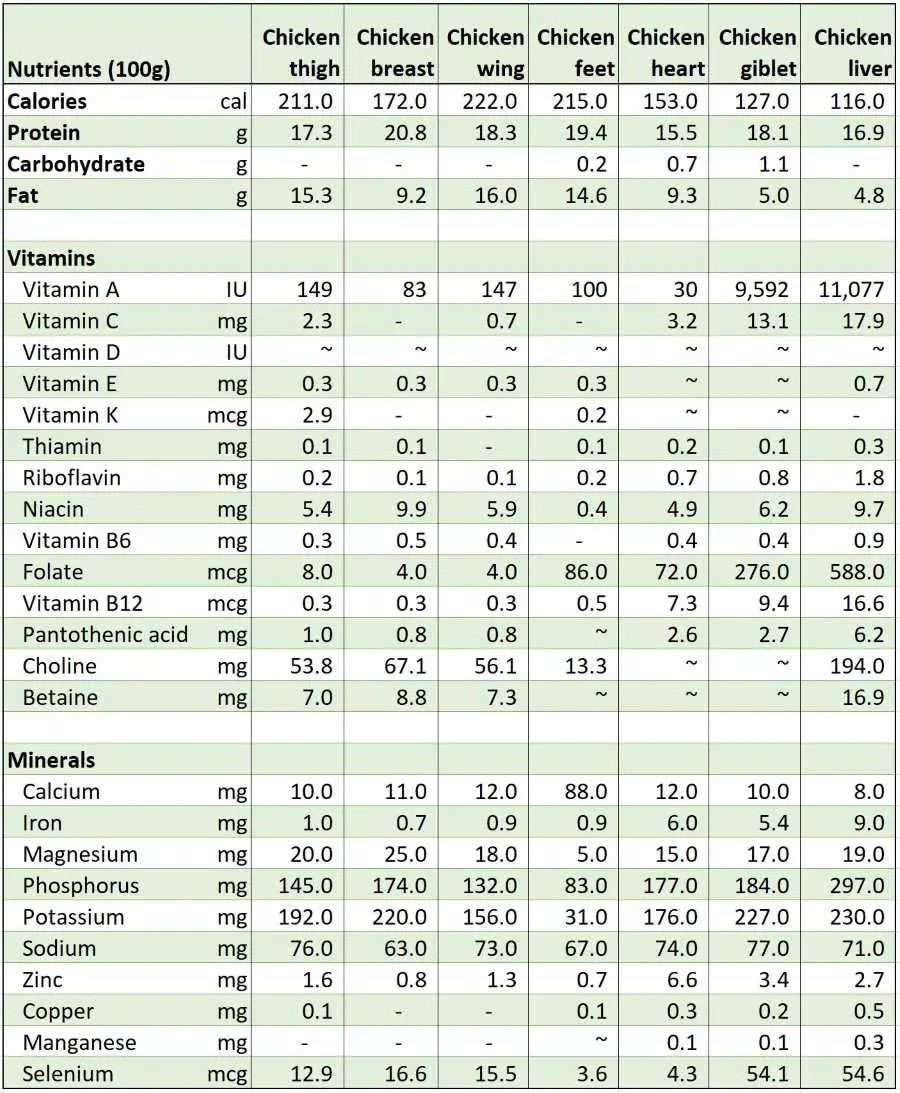
Source of good quality proteins
Chicken is high in good quality proteins. A 100-gram serving of chicken breast delivers 21 grams of complete protein. [1]
Like proteins from other animal sources, proteins in chicken are complete proteins, i.e. they contain all essential amino acids, whereas plant-based proteins generally lack one or two essential amino acids. [2]
Proteins play critical roles in the body. They are essential for building, maintaining, and repairing muscles. They form part of the structure of virtually every cell in the body. They participate in many biological processes in the body including regulating the immune system and gene expression and involving in hormone and neurotransmitter production. [3]
Source of many essential nutrients
Chicken meat and organs are rich in many essential vitamins and minerals as well. They are especially high in B3, B6, B12, selenium, folate, phosphorous, vitamin A, and vitamin C.
For example, a 100-gram serving of chicken breast provides 43%, 23%, 21% and 15% of recommended daily value for vitamin B3 (niacin), vitamin B6, selenium and phosphorous respectively. [4]
Chicken liver is truly a nutrient powerhouse. A 100-gram serving of chicken liver delivers the following: [5]
- Protein: 17 g (34% of DV)
- Vitamin B12: 276% of DV
- Vitamin A: 222% of DV
- Folate: 147% of DV
- Riboflavin (B2): 105% of DV
- Selenium: 78% of DV
- Pantothenic acid (B5): 62% of DV
- Iron: 50% of DV
- Niacin (B3): 49% of DV
- Vitamin B6: 43% of DV
- Phosphorous: 30% of DV
- Vitamin C: 30% of DV
- Copper: 25% of DV
- Thiamin (B1): 20% of DV
- Zinc: 18% of DV
- Manganese: 13%.
It also has small amounts of other nutrients like calcium, magnesium, potassium, and vitamin E.
Source of beneficial bioactive compounds
In addition to being a great source of many nutrients, like other animal-source foods, chicken contains many beneficial bioactive compounds. [6]
| Bioactive Compounds | Meat | Amount (mg/100g) |
|---|---|---|
| L-carnitine | Chicken breast | 10.4 |
| Coenzyme Q10 | Chicken | 1.4 |
| Taurine | Chicken – light meat | 18 |
| Taurine | Chicken – dark meat | 169 |
| Glutathione (GSH) | Chicken breast | 6.5 |
While bioactive compounds like L-carnitine, coenzyme Q10, taurine, creatine, conjugated linoleic acid, and glutathione are not essential for human health, i.e. we can survive without them, they do have many health-promoting effects. [7]
For example, L-carnitine plays a critical role in energy production. In particular, it helps transport long-chain fatty acids into mitochondria so that they be oxidized or burned for energy. Rich sources of L-carnitine are animal-sourced products like beef, lamb, pork, chicken, and turkey. [8, 9]
Another example is coenzyme Q10 which is also called ubiquinone due to the fact that it is ubiquitous, i.e. present everywhere in the human body. The highest level of CoQ10 is found in the heart, liver, kidneys, and pancreas due to these organs’ high rates of metabolism. [10, 11]
CoQ10 is essential for human health. In addition to its primary function in energy production, the enzyme is an important antioxidant which helps protect cells and lipoproteins from oxidation. [12, 13]
CoQ10 has the potential to help prevent or treat many other health conditions including cardiovascular diseases, infertility, high blood pressure, cancer, periodontal diseases, mitochondrial disorders, radiation injury, obesity, diabetes, Parkinson’s disease, Huntington’s disease, AIDS, gastric ulcers, allergy, migraine headaches, kidney failure, muscular dystrophy, and aging. [14, 15, 16]
While the human body produces most of the CoQ10 that it needs, its ability declines after the age of 20. and it is estimated that the level of CoQ10 in heart muscles is reduced to about half at the age of 80. [17]
Therefore, as you get older, foods rich in CoQ10 become increasingly important. Organ meat is a great source of CoQ10, especially the heart. For example, chicken heart has 9.2 mg per 100 g.
Summary
In short, chicken meat and organs are very nutritious. They are packed with good quality proteins, a diverse range of essential nutrients and many health-promoting bioactive compounds.
However, depending on how they are raised, chicken’s fatty acid profile may be not as good as that of ruminants and it can be high in inflammatory omega-6 fatty acids. We will look at this issue in more detail below.
Difference Between Pasture-Raised Chicken and Conventionally-Raised Chicken
The two major differences between pasture-raised and conventionally-raised chickens are their diets and access to the outdoors.
Because chickens are monogastric animals, i.e. they have a single stomach with one chamber, chickens are unable to convert polyunsaturated fats (PUFAs) into saturated fats. [18]
Consequently, if they are fed a diet high in PUFAs (e.g. corn and soy meal), their meat will be high in PUFAs as well. [19]
Chickens are pretty much what they eat.
As humans are monogastric animals like chickens, if we eat a diet high in PUFAs, we will accumulate more PUFAs in our fat as well.
Below, we will look at how chickens are raised on pasture and on factory farms and the implication for the quality of chicken meat.
How chickens are raised on the pasture
Chickens are omnivores. If they are raised on pasture, they will eat insects, bugs, grubs, grass, berries, leaves, seeds and whatever else they can find.
Genuine pasture-raised chickens will spend their time outdoors during the day and only go indoors at night to sleep.
Some small farmers use mobile coops (bottomless houses) that are moved around regularly so that their chickens frequently have access to new pastures.
Being outdoors, they also get sun exposure and a lot of exercise and are free to socialize.
As a result, they are happy and healthy animals and they provide better quality meat.
Pasture-raised chickens are generally given supplementary feed which may have corn and soy and hence result in high PUFA levels in their meat as well.
However, some pasture-raised chickens are fed grains that are free from corn, soy, gluten, and GMOs and are not given antibiotics, growth hormones, or additives.
So, if you buy chickens that are labeled “pasture-raised”, please do check their farming practice because they can vary greatly and result in very different meat qualities.
Our birds are raised outside on pasture 24/7/365 where they can forage for grasses, bugs, seeds, and worms. They move to fresh pasture every single day, and we’ve never given them a single antibiotic or drug… The end result is chicken that’s rich with old school flavor, nutrient dense, and environmentally responsible.
www.pasturebird.com
A comprehensive review by the Compassion in World Farming finds that: [20]
- Free-range and organic chickens have less fat than factory-farmed chickens
- Chicken meat from slower-growing strains has less fat than that from fast-growing strains
- Free-range and organic chicken meat has a higher proportion of omega-3 fatty acids
than factory-farmed chickens - The meat of very slow-growing layer strains has a significantly higher proportion of omega-3
compared with fast and medium growing strains, and the breast meat of these birds has a lower
ratio of omega-6 to omega-3 and is particularly rich in long-chain omega-3, including DHA - Chicken meat from slower-growing strains and from birds reared organically contains more iron than meat from fast-growing strains and factory-farmed chickens.
How chickens are raised conventionally on factory farms
Factory-farmed chickens raised for meat are raised indoors in large sheds at a high density of around 20,000 to 30,000 birds per shed. These chickens usually don’t have access to the outdoors and are likely to spend their entire lives in the sheds. [21]
They are excessively fed grains and oilseed meals or animal by-product meals for fast unnatural growth.
Lights in those sheds are on most of the time to restrict their sleep and keep them eating and growing and, as a result, they are chronically sleep-deprived. [22]
They are also given drugs to control parasites and low-dose antibiotics to prevent or treat diseases likely related to unhealthy living conditions.
Genetic selection results in these chickens’ extremely fast muscle growth but their bones, hearts, and lungs cannot keep up. A large proportion of these chickens have leg problems and can’t support their own weight due to unhealthy excessive growth. [23, 24]
Being forced to squat in their own waste means other health problems follow like breast blisters, hock burn, and chronic dermatitis. Some can’t even move to reach food or water and will die of starvation or dehydration. [25, 26]
In 1925, it took 16 weeks to raise a chicken to 2.5 pounds (1.1 kg). Today, chickens weigh double that in just 6 weeks. [27]
In 1957, the average growth period for a chicken to reach slaughter weight was 63 days. By the 1990s, it took only 38 days and the amount of feed required halved. [28]
The quality of conventionally-raised chicken meat
How chickens are raised has a significant impact on the quality of the meat produced.
As can be seen in the table below, more than 20% of the fat in factory-farmed chicken is PUFAs. This is extremely high compared to ruminants. For example, only around 3-4% of beef and lamb fats are PUFAs. [29]
The omega 6 to omega 3 ratio of factory-farmed chicken meat is also very high at around 14 to 15 whereas this ratio in beef and lamb fats is between 1 and 2 only. [30]
That means most of the PUFAs in chicken meat are inflammatory omega-6 fatty acids.
As a comparison, our ancestors are thought to have consumed a diet with an omega 6-to-omega 3 ratio of only around 1:1. [31]
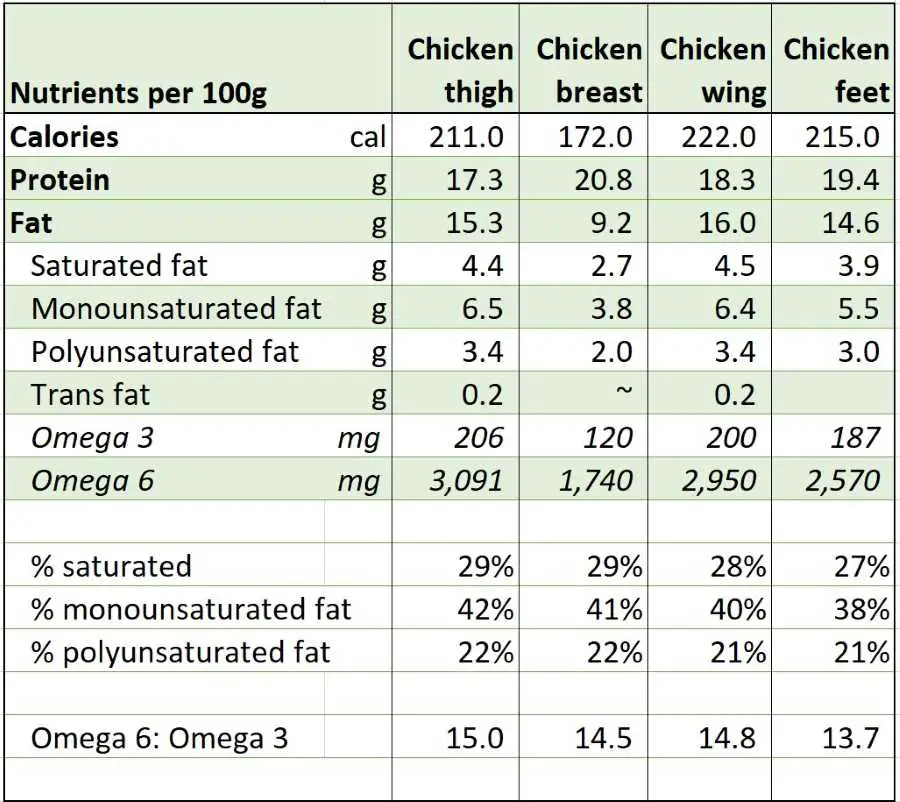
PUFAs are fats with more than one unsaturated carbon bond (double bond) in the molecule and are liquid at room temperature.
Due to their unstable chemical structure, PUFAs are prone to damages from high heat cooking, prolonged light exposure, and oxygen. Oxidized fats are inflammatory and linked to many modern health problems. [32]
PUFAs are linked to many chronic inflammatory diseases such as nonalcoholic fatty liver disease, cardiovascular disease, obesity, inflammatory bowel disease, rheumatoid arthritis, Alzheimer’s disease, and even cancer. [33, 34]
Why It’s Okay to Eat Pasture-Raised Chicken on the Carnivore Diet
It is clear from above that genuine pasture-raised chickens are healthy and happy animals that produce superior meat quality compared to factory-farmed chickens.
If you can raise your own chickens or have access to good quality pasture-raised chickens, I don’t see any reasons to restrict chicken consumption on the carnivore diet.
However, it is important to find out how the chickens that are labeled “pasture-raised” are actually fed. If they have access to pasture but are fed the same feed as factory-farmed chickens, their fat is likely to have a high concentration of PUFAs as well.
The only concern that I have with pasture-raised chickens is their low-fat content.
Genuine pasture-raised chickens are very lean and if you eat a lot of them, you may not get enough fat in your diet.
Chicken breast is very lean and would deliver a fat to protein ratio of less than 50% while chicken thighs and wings deliver a fat to protein ratio of around 60%.
The fat to protein ratio that most people on the carnivore diet feel best on is around 70% to 80%.
However, this problem can be easily fixed by just adding ruminant fat trimming or fatty ruminant cuts to your diet.
Also, remember to practice eating nose to tail as much as possible. As can be seen in the first table, chicken organs are incredibly nutritious. They are also very affordable and don’t have a strong offal taste like their ruminant counterparts.
What about organic chicken?
Organic chickens are generally fed 100% organic feed with no use of hormones, antibiotics or GMOs and have outdoor access.
However, if their feed contains a lot of corn and soy, their fats will be high in PUFAs. As mentioned above, chickens are what they eat.
So, you do need to check what “organic” certification actually means if you are buying organic chicken meat.
What about free-range chicken?
Free-range chickens get access to the outdoors but, again, you do need to check what a particular “free-range” certification means because different certification organizations can have different sets of requirements.
If free-range chickens are fed the same diet as caged chickens and allowed outdoor access for only a few hours a day, their meat quality is unlikely to be much different from that of intensive factory-farmed chickens.
Why You Should Avoid Conventionally-Raised Chicken on the Carnivore Diet
Given what we learn about how factory-farmed chickens are raised, it is clear that we should avoid eating chicken on the carnivore diet if we have the choice.
Factory-farmed chickens have a high PUFA level and may contain antibiotics and other drugs.
Ruminant meat, fat and organ (e.g. beef, lamb, bison, and buffalo) are the best staple food on the carnivore diet. There is no nutrient in chicken that you can’t find in ruminant-sourced food.
Having said that, if chicken is all you can afford or can eat for whatever reasons, my view is that it is still a lot better than faked meat and other plant-based protein sources. It is nutrient-dense, highly bioavailable and free from anti-nutrients.
One solution is to go for lean chicken meat and chicken organs (which have a lower fat content) to avoid loading up on too much PUFAs.
However, you do need to rely on fats on the carnivore diet as your main source of energy, so a possible solution could be to eat lean chicken meat with good quality fats like beef fat, lamb fat, butter, and ghee.
Needless to say, you should stay away from all deep-fried breaded chicken and processed chicken meat.
Conclusion
Unless you raise your own chickens and know what goes in their feed or can get chicken meat from a trusted farmer, avoid chicken or consume it very sparingly on the carnivore diet.
Other posts you might be interested in:
Do You Need to Eat Fish on the Carnivore Diet?
Pork on the Carnivore Diet: Yay or Nay?
Are Eggs Okay on the Carnivore Diet?
Is Honey Okay on the Carnivore Diet?
Do You Need Supplements on the Carnivore Diet?
Disclaimer: The information in this post is for reference purposes only and not intended to constitute or replace professional medical advice. Please consult a qualified medical professional before making any changes to your diet or lifestyle.
Photo credit: JK Sloan on Unsplash.

